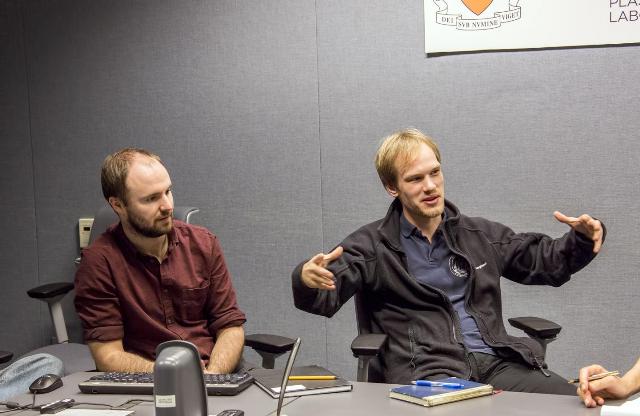Dec 23 2015
A system of antennas similar to those that astrophysicists use to study radio emissions from stars and galaxies will help shed light on fusion experiments at the U.S. Department of Energy's Princeton Plasma Physics Laboratory (PPPL). Called Synthetic Aperture Microwave Imaging (SAMI), the system aims to provide highly precise time and spatial resolution measurements of the density of current at the edge of fusion plasmas in the National Spherical Torus Experiment-Upgrade (NSTX-U) -- the Laboratory's newly upgraded flagship facility that is set to embark on compelling new research programs.
 David Thomas and Jakob Brunner. Credit: Elle Starkman/PPPL Office of Communications
David Thomas and Jakob Brunner. Credit: Elle Starkman/PPPL Office of Communications
High-resolution measurements of the edge current density are key to understanding instabilities called Edge Localized Modes (ELMs) that can foil experiments in the H-mode regime that marks high-level performance of fusion plasmas. Large ELMs can eject significant amounts of energy that can damage the vacuum vessels of tokamaks that house fusion reactions and generate impurities that can significantly degrade the reactions.
The two graduate students, David Thomas of the University of York and Jakob Brunner of Durham University brought the SAMI system, which consists of an array of eight antennas, to PPPL from Britain in November. It was originally installed on the Mega Amp Spherical Tokamak (MAST) at the United Kingdom's Culham Centre for Fusion Energy; MAST is an NSTX-U-like system that is currently shut down for a major upgrade. Now modified to meet NSTX-U requirements, the SAMI plasma diagnostic will start acquiring significant amounts of data during the 2016 NSTX-U research campaign.
Passive and active functions
The antennas have both passive and active functions. They passively map the conversion of what are called "electron Bernstein waves" inside the plasma to microwave radiation near the edge of the plasma. The image of this microwave emission is characterized by two bright regions and the steepness of the line between these two regions depends on the local plasma current density.
The diagnostic measures microwave emission in a wide range of frequencies that correspond to different locations in the edge of the plasma. SAMI can therefore be used to map the profile of current density with much higher resolution than is possible with other plasma diagnostics on NSTX-U.
SAMI also uses two antennas in the array to actively probe turbulence in the plasma by launching radar-like waves that bounce off the turbulence that takes the form of filaments called "blobs." On MAST, the system imaged the velocity and size of these blobs to produce the first two-dimensional map of the velocity of the turbulence itself -- a critical factor that allows heat to leak from fusion experiments.
Thomas and Brunner, who were at the Lab in November, worked with engineer Bob Ellis, physicist Gary Taylor and technicians to install the system and gave talks on it to NSTX-U staffers. They will return early next year to complete the installation and hook up the turbulence-probing mechanisms.